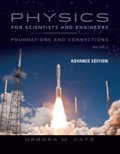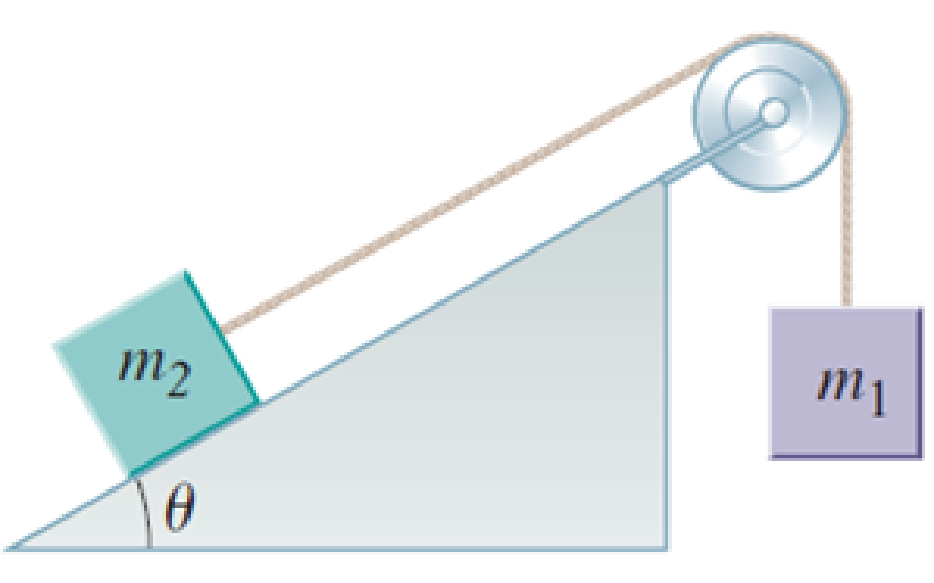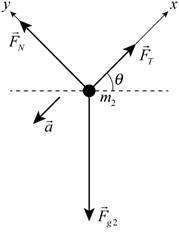
Concept explainers
Two boxes with masses m1 = 4.00 kg and m2 = 10.0 kg are attached by a massless cord passing over a frictionless pulley as shown in Figure P5.79. The incline is frictionless, and θ = 30.0°.
- a. Draw a free-body diagram for each of the boxes.
- b. What is the magnitude of the acceleration of the boxes?
- c. What is the tension in the cord connecting the boxes?
- d. What is the speed of each of the boxes 3.00 s after the system is released from rest?

FIGURE P5.79
(a)
Draw the free body diagram for each of the boxes.
Answer to Problem 79PQ
The free body diagram for each of the boxes is given below.
Explanation of Solution
The free body diagram each of the boxes is given below.
Conclusion:


(b)
Find the acceleration of the boxes.
Answer to Problem 79PQ
The acceleration of the boxes is
Explanation of Solution
Applying Newton’s laws,
Here,
Here,
Substitute equation II in equation I.
Conclusion:
Substitute
Therefore, the acceleration of the boxes is
(c)
Find the tension in the cord connecting the boxes.
Answer to Problem 79PQ
The tension in the cord connecting the boxes is
Explanation of Solution
Use the equation II to find the tension in the rope connecting the two sleds.
Conclusion:
Substitute
Therefore, the tension in the rope connecting the two sleds is
(d)
Find the speed of the boxes
Answer to Problem 79PQ
The speed of the boxes
Explanation of Solution
As the boxes are at rest initially, write the equation of final speed.
Here,
Conclusion:
Substitute
Therefore, the speed of the boxes
Want to see more full solutions like this?
Chapter 5 Solutions
EBK PHYSICS FOR SCIENTISTS AND ENGINEER
- The velocity of a particle moves along the x-axis and is given by the equation ds/dt = 40 - 3t^2 m/s. Calculate the acceleration at time t=2 s and t=4 s. Calculate also the total displacement at the given interval. Assume at t=0 s=5m.Write the solution using pen and draw the graph if needed.arrow_forwardThe velocity of a particle moves along the x-axis and is given by the equation ds/dt = 40 - 3t^2 m/s. Calculate the acceleration at time t=2 s and t=4 s. Calculate also the total displacement at the given interval. Assume at t=0 s=5m.Write the solution using pen and draw the graph if needed. NOT AI PLSarrow_forwardThe velocity of a particle moves along the x-axis and is given by the equation ds/dt = 40 - 3t^2 m/s. Calculate the acceleration at time t=2 s and t=4 s. Calculate also the total displacement at the given interval. Assume at t=0 s=5m.Write the solution using pen and draw the graph if needed.arrow_forward
- The velocity of a particle moves along the x-axis and is given by the equation ds/dt = 40 - 3t^2 m/s. Calculate the acceleration at time t=2 s and t=4 s. Calculate also the total displacement at the given interval. Assume at t=0 s=5m.Write the solution using pen and draw the graph if needed.arrow_forwardPlease don't use Chatgpt will upvote and give handwritten solutionarrow_forwardNo chatgpt pls will upvote Already got wrong chatgpt answerarrow_forward
- An electron and a proton are each accelerated through a potential difference of 21.0 million volts. Find the momentum (in MeV/c) and the kinetic energy (in MeV) of each, and compare with the results of using the classical formulas. Momentum (MeV/c) relativistic classical electron proton Kinetic Energy (MeV)arrow_forwardFour capacitors are connected as shown in the figure below. (Let C = 20.0 µF.) (a) Find the equivalent capacitance between points a and b. µF (b) Calculate the charge on each capacitor, taking ΔVab = 14.0 V. 20.0 µF capacitor µC 6.00 µF capacitor µC 3.00 µF capacitor µC capacitor C µCarrow_forward11. At what point in SHM is the velocity maximum? Displacement maximum?arrow_forward
 Physics for Scientists and Engineers, Technology ...PhysicsISBN:9781305116399Author:Raymond A. Serway, John W. JewettPublisher:Cengage Learning
Physics for Scientists and Engineers, Technology ...PhysicsISBN:9781305116399Author:Raymond A. Serway, John W. JewettPublisher:Cengage Learning Physics for Scientists and Engineers: Foundations...PhysicsISBN:9781133939146Author:Katz, Debora M.Publisher:Cengage Learning
Physics for Scientists and Engineers: Foundations...PhysicsISBN:9781133939146Author:Katz, Debora M.Publisher:Cengage Learning University Physics Volume 1PhysicsISBN:9781938168277Author:William Moebs, Samuel J. Ling, Jeff SannyPublisher:OpenStax - Rice University
University Physics Volume 1PhysicsISBN:9781938168277Author:William Moebs, Samuel J. Ling, Jeff SannyPublisher:OpenStax - Rice University Principles of Physics: A Calculus-Based TextPhysicsISBN:9781133104261Author:Raymond A. Serway, John W. JewettPublisher:Cengage Learning
Principles of Physics: A Calculus-Based TextPhysicsISBN:9781133104261Author:Raymond A. Serway, John W. JewettPublisher:Cengage Learning College PhysicsPhysicsISBN:9781305952300Author:Raymond A. Serway, Chris VuillePublisher:Cengage Learning
College PhysicsPhysicsISBN:9781305952300Author:Raymond A. Serway, Chris VuillePublisher:Cengage Learning College PhysicsPhysicsISBN:9781285737027Author:Raymond A. Serway, Chris VuillePublisher:Cengage Learning
College PhysicsPhysicsISBN:9781285737027Author:Raymond A. Serway, Chris VuillePublisher:Cengage Learning





